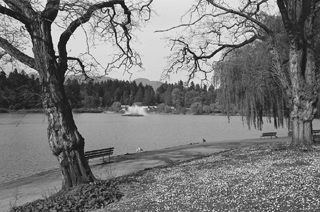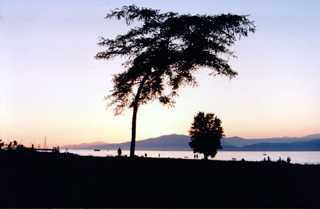
Taken during a walk with Astrid in late April 2005, this photo shows Lost Lagoon in Vancouver’s Stanley Park. Nearby, to the southeast, is Vancouver’s central urban district. Equally close, to the north and through the park, is the southern end of the Lions Gate Bridge to North Vancouver.
In an announcement particularly relevant to those who live outside of big cities, the Perseid meteor shower will reach its peak of intensity tonight. Generated from dust and fragments from comet Swift-Turtle, the Perseid shower occurs annually. The comet in question was discovered in 1862 and is notable for being the largest object that regularly approaches the earth.
The best time to see the shower is in the hours immediately before dawn, but there should be more than eighty meteors per hour visible to the naked eye for most of the night, for those in reasonably dark places. Because of the way in which the planet rotates, the rate at which the meteors appear is about twice as high right before dawn as it is shortly after sunset. This is because, at that time, the particular part of the planet’s surface where you are is both hidden from the sun and facing in the direction of its the planet’s around the sun. Because of that combination, the most visible collisions with material from the comet will occur.
The shower is called the Perseids because the meteors appear to be coming from the constellation Perseus. Those who are going out to watch may find it worthwhile to familiarize themselves with how the constellation looks and where in the sky it appears.
If anyone has a particularly dramatic experience, I would be glad to hear about it here. I continue to look up with dismay at the thick rain clouds over Oxford.
[Update: 13 August 2006] On account of the constant presence of rain clouds blocking the sky and reflecting back city light, I saw not a single meteor. I hope others did better.



